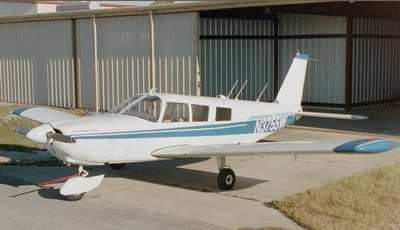Aircraft Hit A Radio Tower Guide Wire In
Instrument Conditions
 The NTSB has released its
preliminary findings in the crash in Tulsa, Oklahoma last week of a
Piper PA-32 in which the pilot and four passengers were killed. The
airplane hit a radio tower guide wire. Impact with the ground was
followed by a post-crash fire.
The NTSB has released its
preliminary findings in the crash in Tulsa, Oklahoma last week of a
Piper PA-32 in which the pilot and four passengers were killed. The
airplane hit a radio tower guide wire. Impact with the ground was
followed by a post-crash fire.
NTSB Identification: CEN09FA562
14 CFR Part 91: General Aviation
Accident occurred Saturday, September 05, 2009 in Tulsa, OK
Aircraft: PIPER PA-32R-300, registration: N1228H
Injuries: 5 Fatal.
This is preliminary information, subject to change, and may
contain errors. Any errors in this report will be corrected when
the final report has been completed.
On September 5, 2009 at 1042 Central Daylight Time, a Piper
PA-32R-300, N1228H, struck a radio tower guide wire and
subsequently struck the ground 8 miles northwest of the Richard
Lloyd Jones, Jr./Riverside Airport (KRVS), Tulsa, Oklahoma.
Instrument meteorological conditions prevailed and an instrument
flight rules flight plan was on file for the Title 14 CFR Part 91
flight from KRVS to Dallas Love Field (KDAL), Dallas, Texas. The 5
persons on board were fatally injured. The airplane was destroyed
from impact forces and a subsequent post-crash fire. The personal
flight originated approximately 1035.
The accident site was located within the confines of Chandler
Park, located at 6500 West 21st Street, west of Tulsa,
Oklahoma.

Pier PA-32 File Photo
The accident site began at a 600-foot tall radio tower that was
located near the center of the park. A 7-strand steel guy-wire
supporting the tower on its west side and located approximately 150
feet up from the tower’s base, was severed approximately 50
feet out from where the wire attached to the tower. A 300-foot
section of the wire was located with the airplane main wreckage
approximately 1,575 feet west of the tower.
The airplane main wreckage was located on top of a grassy knoll.
The immediate crash scene began with a 33-foot long scrape in the
ground culminating with a 9-foot long, 6-foot wide and 18-inch deep
gouge in the ground that ran along a 276-degree magnetic heading. A
spray of dirt extended outward from the gouge in a 14-degree arc
along an average heading of 250-degrees for approximately 150 feet.
A burned area of grass extended along a 250-degree heading from the
gouge to the airplane main wreckage. The burned area was
approximately 285 feet long and 42 feet wide.
The airplane main wreckage was located approximately 282 feet
from the initial ground scrapes. The 300-foot long section of cable
from the radio tower wound around the cabin and ran aft of the
airplane, down the knoll to the south. The airplane main wreckage
consisted of the airplane’s cabin section, the baggage
compartment and aft fuselage, the empennage, and the engine and
propeller. The main wreckage was oriented on a 350-degree magnetic
heading.
The airplane wreckage was recovered and moved to a secure
storage facility. The engine was set aside for further
examination.
At 1035, the weather at KRVS was ceiling 600 feet overcast, 4
miles visibility with haze, temperature 22 degrees Centigrade (C),
dew point 19 degrees C, and altimeter 30.11 inches.
 ANN's Daily Aero-Term (04.20.24): Light Gun
ANN's Daily Aero-Term (04.20.24): Light Gun Aero-News: Quote of the Day (04.20.24)
Aero-News: Quote of the Day (04.20.24) ANN's Daily Aero-Linx (04.21.24)
ANN's Daily Aero-Linx (04.21.24) Aero-News: Quote of the Day (04.21.24)
Aero-News: Quote of the Day (04.21.24) ANN's Daily Aero-Term (04.21.24): Aircraft Conflict
ANN's Daily Aero-Term (04.21.24): Aircraft Conflict




